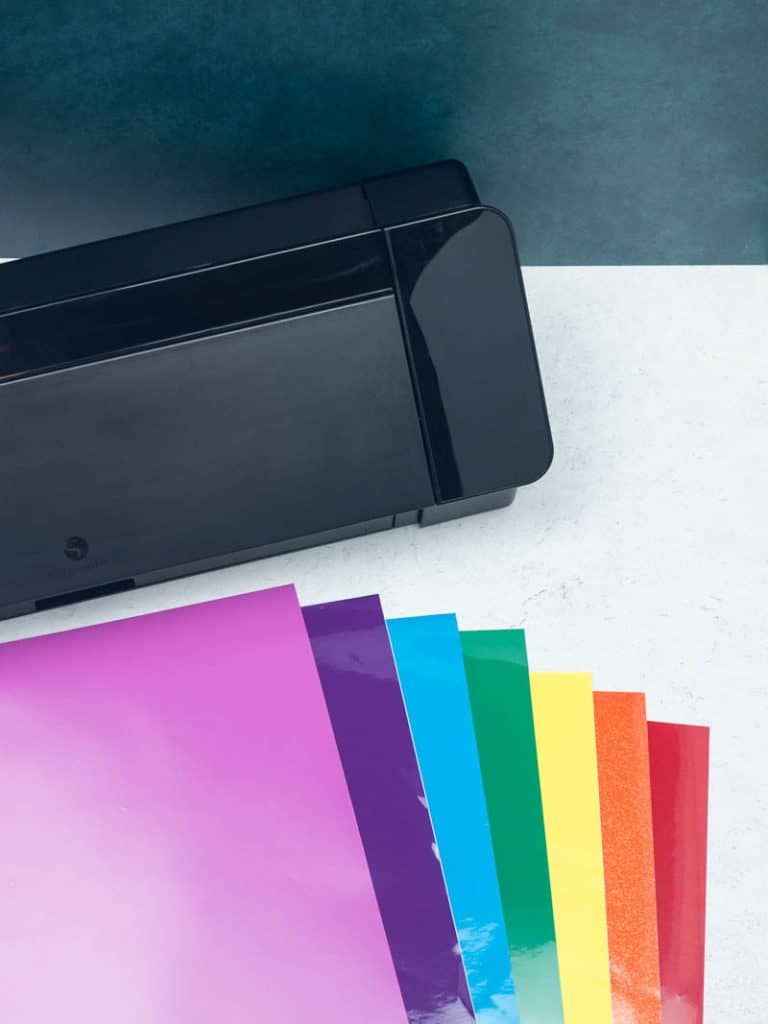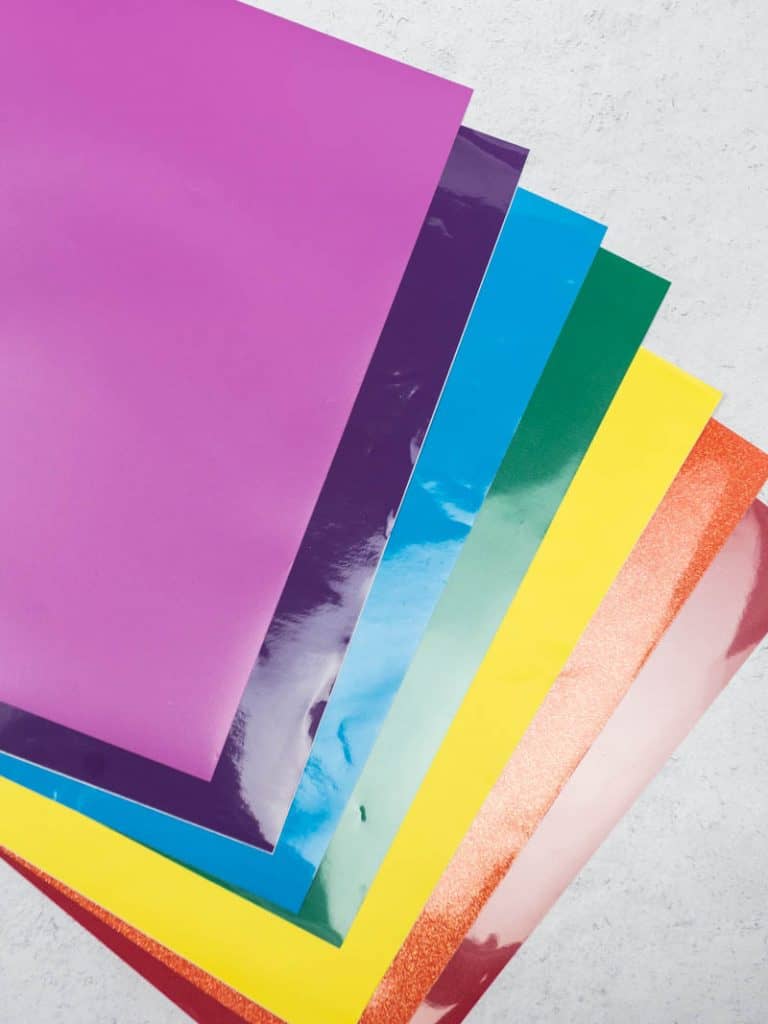Beginners Guide to Craft Vinyl: Heat Transfer Vinyl vs Adhesive Vinyl
This post contains affiliate links. I may earn commission from qualifying purchases at no additional cost to you. I will never recommend a product I don’t use or trust.
Are you unsure about the differences between heat transfer vinyl vs adhesive vinyl? In this beginners guide to craft vinyl we’re going to tell you what each type is, how to use them, what projects to use them on and where we buy our vinyl from!

Have you ever gone into your craft space to grab vinyl for a project and not known if you are holding heat transfer vinyl or adhesive vinyl?
Or have you cut your design out only to realize you used adhesive vinyl instead of heat transfer vinyl for your t-shirts?
That can be really frustrating when you realize how much time you’ve wasted and now you have to start back at the beginning. But there is a really easy way to tell the two types of vinyl apart!
We’re going to deep dive into heat transfer vinyl vs adhesive vinyl and give you tips to help you figure out which ones to use for your projects, how to tell them apart and our favorite places to buy the vinyl from!
I’m totally ready to make all the 4th of July crafts for this year. I might be making up for last year a little bit, but I’m excited for it!
This All American Family svg has a bit of a retro look to it but it is absolutely perfect for all the 4th of July crafts you can make!
I’m going to show you 4 different ways to use this All American Family SVG cut file today, including layering adhesive vinyl on a wood sign and how to layer the decal on a tea towel!
The best places to buy craft vinyl
There are lots of places to buy craft vinyl from! My favorites (if you can wait for shipping) are:
- Expressions Vinyl (always good deals, fast shipping and the quality of vinyl is the best!)
- Swing Design (shipping seems to take a little bit longer but the vinyl quality is good)
- Amazon (Prime shipping makes this one of the fastest ways to get vinyl but you really need to look at the description to make sure you’re getting the right type of craft vinyl).
You can go into your local craft store (Michaels, Hobby Lobby or JoAnn’s) and see what you can find. I personally do not like the Cricut or Silhouette vinyl so I never buy them. Michaels also carries Siser Easyweed Vinyl now…but it is expensive per roll and I refuse to buy it from them unless I’m really in a bind.
I really don’t like the Hobby Lobby brand vinyl either. But again, if you’re in a pinch you can try it!
I also wrote an entire post on where to buy patterned vinyl that you can find here! Patterned vinyl comes in both heat transfer and adhesive so you can use it for any project!
What are the different types of craft vinyl?
There are two basic types of craft vinyl that we are going to talk about: heat transfer vinyl and adhesive vinyl.
Adhesive vinyl (also known as permanent vinyl) is a thin material that uses pressure sensitive adhesive to adhere to different materials. You can cut any type of design out of this vinyl and apply it to hard, even surfaces.
Heat transfer vinyl (also knows as iron on vinyl or HTV) is a thin material that uses a heat activated adhesive to adhere to different materials. You can use HTV on wood, fabric or any other type of material that can withstand heat.
Both adhesive vinyl and heat transfer vinyl come in rolls or sheets that are 12 inches wide and vary in length.
The Beginners Guide to Craft Vinyl – let’s dig in!
How do you tell the difference between heat transfer vinyl vs adhesive vinyl?
If you are holding two pieces of vinyl in your hand and cannot tell what type of vinyl they are, there is one easy way to find out!
All adhesive vinyl has a paper backing on the backside of the vinyl.
If you turn over your vinyl and find a paper backing, you’re holding adhesive vinyl.
If you turn it over and it’s the same color on both sides, you have heat transfer vinyl.
Heat transfer vinyl has one shiny side and one matte side. The shiny side has a clear carrier sheet on top that protects your vinyl when you use a heat press on it. The shiny side will always face down on the mat, you never want to cut with the shiny side up with heat transfer vinyl!
What type of Adhesive Vinyl should I use for my projects?
Indoor vinyl vs. outdoor vinyl
Some adhesive vinyl is meant for permanent applications whereas others are meant to be removable. To tell which one is which, look at the vinyl: is it glossy or is it matte? If it’s glossy you most likely have permanent vinyl. Matte vinyl is typically removable vinyl.
If you’re using Oracle vinyl, it actually says on the back which type you’re using. So always check the paper backing to see what it says if you’re unsure!
651 Oracle Vinyl (adhesive vinyl) is a permanent vinyl you can use on mugs, wood signs, keychains, acrylic blanks, car decals and more.
631 Oracle Vinyl (removable vinyl) can be used on walls, as stencils and on wood signs. It has a shorter shelf life than 651 vinyl though (3 years indoors and 1 year outdoors) so it is not a good option if you want something more permanent.
Stencil Vinyl
You’ll find a few different kinds of stencil vinyl at the store but my absolute favorite is Oramask 813! It’s very easy to cut and when used correctly (ie: no bubbles when you lay it on your material) it stops the paint from bleeding through.
I have used Oramask 813 on most of my wood signs, my favorite being these Star Wars signs I made for Chris’s office. This post is a full tutorial on how to stop paint from bleeding through your stencil, something you must read before painting signs!
What type of heat transfer vinyl should I use for my projects?
You may know heat transfer vinyl by one of these names: htv, iron on vinyl or heat transfer vinyl. They are all the same thing!
My favorite type of htv to use is Siser Easyweed. True to its name it is easy to weed and very easy to cut! It is the best heat transfer vinyl to start out with.
Some of the other types of HTV you can use are:
- Flocked Vinyl – Flocked Vinyl is raised and great because it’s easy to cut for beginners. We used it in this project and loved it!
- Holographic Vinyl – a very shiny type of vinyl that can be a pain to cut if your blade isn’t sharp enough. But it looks great on trick or treat bags!
- Electric Easyweed Vinyl – my favorite reflective vinyl when I need lots of bold color that looks really cool on a t-shirt!
- Deco Foil – need to use with Easyweed Adhesive but its a fun and different type of material to try, which you can see here!
- Patterned Vinyl – adds character to your projects and there are so many fun patterns to choose from, like this cactus print!
Heat transfer vinyl can be used on any type of fabric that can withstand heat, but these are some of my favorite materials to use it on:
- Wood – like my favorite wood Christmas ornaments!
- T-shirts – these Monsters INC Halloween costumes are the best!
- Tote Bags – we make our own trick or treat bags every year!
- Kitchen Towels – this gather svg is perfect in a kitchen!
- Wood Signs – this Hello Pumpkin sign is one of my favorites!
Want to know more about heat transfer vinyl? Check out this post that is all about htv and how you can use it on t-shirts!

So what type of vinyl should I try first?
If you’re a beginner just starting out with vinyl, removable vinyl is the best one to start out with. It’s not as tacky as permanent vinyl so it is easy to pick up and move if you need to.
Removable vinyl is fun to use on a diy coir doormat or a holiday wood sign as a stencil!
I also used it here for this Gamer Dad project. I liked the idea of using it on a computer decal because I could easily take it off if I wanted something different later on.
Any time you’re using permanent vinyl or removable vinyl, don’t forget your transfer tape! You can read all about what transfer tape is and how to use it here.
If you want to get started with heat transfer vinyl, Flocked Vinyl or Siser Easyweed are my two choices. I personally love Easyweed because my Cameo 4 Autoblade cuts through it like butter. But both are good ones to start out with!
Though that was a lot of information to throw at you I hope that all of it helped explain the differences between heat transfer vinyl vs adhesive vinyl!
Have fun crafting!


Great information! Thank you!